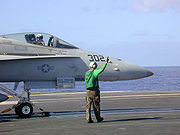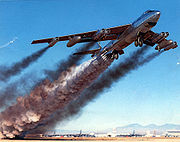
Assisted take off
Encyclopedia

Aircraft
An aircraft is a vehicle that is able to fly by gaining support from the air, or, in general, the atmosphere of a planet. An aircraft counters the force of gravity by using either static lift or by using the dynamic lift of an airfoil, or in a few cases the downward thrust from jet engines.Although...
into the air (as opposed to strictly under its own power). The reason it might be needed is due to the aircraft's weight exceeding the normal maximum take off weight, insufficient power, or the available runway
Runway
According to ICAO a runway is a "defined rectangular area on a land aerodrome prepared for the landing and take-off of aircraft." Runways may be a man-made surface or a natural surface .- Orientation and dimensions :Runways are named by a number between 01 and 36, which is generally one tenth...
length may be insufficient, or a combination of all three factors. Assisted take off
Takeoff
Takeoff is the phase of flight in which an aerospace vehicle goes from the ground to flying in the air.For horizontal takeoff aircraft this usually involves starting with a transition from moving along the ground on a runway. For balloons, helicopters and some specialized fixed-wing aircraft , no...
is also required for gliders
Glider (sailplane)
A glider or sailplane is a type of glider aircraft used in the sport of gliding. Some gliders, known as motor gliders are used for gliding and soaring as well, but have engines which can, in some cases, be used for take-off or for extending a flight...
, which do not have an engine and are unable to take off by themselves.
Catapults (CATO)

Aircraft catapult
An aircraft catapult is a device used to launch aircraft from ships—in particular aircraft carriers—as a form of assisted take off. It consists of a track built into the flight deck, below which is a large piston or shuttle that is attached through the track to the nose gear of the aircraft, or in...
. In modern systems fitted on aircraft carrier
Aircraft carrier
An aircraft carrier is a warship designed with a primary mission of deploying and recovering aircraft, acting as a seagoing airbase. Aircraft carriers thus allow a naval force to project air power worldwide without having to depend on local bases for staging aircraft operations...
s, a piston, known as a shuttle, is propelled down a long cylinder under steam pressure. The aircraft is attached to the shuttle using a tow bar or launch bar mounted to the nose landing gear (an older system used a steel cable called a catapult bridle; the forward ramps on older carrier bows were used to catch these cables), and is flung off the deck at about 15 knots above minimum flying speed, achieved by the catapult in a 4 second run.
The United States
United States
The United States of America is a federal constitutional republic comprising fifty states and a federal district...
is replacing carrier steam catapults with linear induction motor
Linear induction motor
A linear induction motor is an AC asynchronous linear motor that works by the same general principles as other induction motors but which has been designed to directly produce motion in a straight line....
s. The system is called the Electromagnetic Aircraft Launch System (EMALS). An electromagnetic wave travelling through the motor propels the armature
Armature (electrical engineering)
In electrical engineering, an armature generally refers to one of the two principal electrical components of an electromechanical machine–generally in a motor or generator, but it may also mean the pole piece of a permanent magnet or electromagnet, or the moving iron part of a solenoid or relay....
along its length, pulling the plane with it. With this system, it will be possible to match launch power and aircraft weight more closely than with the steam system, causing less wear on the aircraft.
The catapult approach is also used for towing gliders into the air. This can be accomplished using an elastic bungee cord
Bungee cord
A bungee cord , also known as a shock cord, is an elastic cord composed of one or more elastic strands forming a core, usually covered in a woven cotton or polypropylene sheath...
arrangement, or more commonly using a cable wound onto a winch
Winch
A winch is a mechanical device that is used to pull in or let out or otherwise adjust the "tension" of a rope or wire rope . In its simplest form it consists of a spool and attached hand crank. In larger forms, winches stand at the heart of machines as diverse as tow trucks, steam shovels and...
, powered by a large diesel engine
Diesel engine
A diesel engine is an internal combustion engine that uses the heat of compression to initiate ignition to burn the fuel, which is injected into the combustion chamber...
. The bungee approach is rarely used for man-carrying gliders, as the acceleration is uncontrolled and can yield very high G-forces. It is commonly used to launch model glider
Model aircraft
Model aircraft are flying or non-flying models of existing or imaginary aircraft using a variety of materials including plastic, diecast metal, polystyrene, balsa wood, foam and fibreglass...
s however. Manned gliders are commonly launched simply by towing them aloft behind a powered aircraft.

JATO and RATO
JATOJATO
JATO is an acronym for jet-fuel assisted take off. It is a system for helping overloaded aircraft into the air by providing additional thrust in the form of small rockets....
stands for 'Jet-assisted take off' (and the similar RATO for 'Rocket-assisted take off'). In the JATO and RATO systems, additional engines are mounted on the airframe which are used only during take off. After that the engines are usually jettisoned, or else they just add to the parasitic weight and drag of the aircraft. However some aircraft such as the Avro Shackleton
Avro Shackleton
The Avro Shackleton was a British long-range maritime patrol aircraft for use by the Royal Air Force. It was developed by Avro from the Avro Lincoln bomber with a new fuselage...
MR.3 Phase 2, had permanently attached JATO engines. The four J-47 turbojet engines on the B-36 were not considered JATO systems; they were an integral part of the aircraft's powerplants, and were used during takeoff, climb, and cruise at altitude.
During WW2 the German Arado 234 and the Messerschmitt 323 "Gigant" used rocket units beneath the wings for assisted take off.
Such systems were popular during the 1950s, when heavy bombers started to require two or more miles of runways to take off fully laden. This was exacerbated by the relatively low power available from jet engine
Jet engine
A jet engine is a reaction engine that discharges a fast moving jet to generate thrust by jet propulsion and in accordance with Newton's laws of motion. This broad definition of jet engines includes turbojets, turbofans, rockets, ramjets, pulse jets...
s at the time - for example the B-52 Stratofortress
B-52 Stratofortress
The Boeing B-52 Stratofortress is a long-range, subsonic, jet-powered strategic bomber operated by the United States Air Force since the 1950s. The B-52 was designed and built by Boeing, who have continued to provide maintainence and upgrades to the aircraft in service...
required 8 turbojet engines to yield the required performance, and still needed RATO for very heavy payloads ( a proposed update of the B-52 replaces these with half the number of much more powerful engines).

Cold War
The Cold War was the continuing state from roughly 1946 to 1991 of political conflict, military tension, proxy wars, and economic competition between the Communist World—primarily the Soviet Union and its satellite states and allies—and the powers of the Western world, primarily the United States...
context, RATO and JATO bottles were seen as a way for fighter aircraft to utilize the undamaged sections of runways of airfields which had been attacked.
Gravity assistance
Early pioneers in powered and unpowered flight used gravity to accelerate their aircraft to a speed which allowed its wings to generate enough lift to achieve independent flight. These included attempts to achieve flight from towers, city walls and cliffs. Generally more successful were attempts in which speed was built up by accelerating down hill and mountain slopes, sometimes on rails or ramps.Carrier aircraft
Probably the ultimate form of gravity assistance is when an aircraft is released from a larger mother shipMother ship
A mother ship is a vessel or aircraft that carries a smaller vessel or aircraft that operates independently from it. Examples include bombers converted to carry experimental aircraft to altitudes where they can conduct their research , or ships that carry small submarines to an area of ocean to be...
or mother craft. This may be because the daughter craft is incapable of taking off normally e.g. the atmospheric flight tests of the Space Shuttle.

Bell X-1
The Bell X-1, originally designated XS-1, was a joint NACA-U.S. Army/US Air Force supersonic research project built by Bell Aircraft. Conceived in 1944 and designed and built over 1945, it eventually reached nearly 1,000 mph in 1948...
and other X-planes.
In the interwar years in order to achieve long ranges with the technology of the time, trials were undertaken with float planes piggy backed atop flying boats. With the float plane carried part of the way to its destination and freed from having to use any of its own fuel in the initial climb these combinations could deliver light but time critical cargos faster and farther than a single individual aircraft (see Short Mayo Composite
Short Mayo Composite
The Short Mayo Composite was a piggy-back long-range seaplane/flying boat combination produced by Short Brothers to provide a reliable long-range air transport service to the United States and the far reaches of the British Empire and the Commonwealth....
).
Hot air balloons have acted as "motherships" to hang gliders
Hang gliding
Hang gliding is an air sport in which a pilot flies a light and unmotorized foot-launchable aircraft called a hang glider ....
and para gliders
Paragliding
Paragliding is the recreational and competitive adventure sport of flying paragliders: lightweight, free-flying, foot-launched glider aircraft with no rigid primary structure...
in altitude and distance record attempts.
"Jet Donkeys"
An unusual assisted take off scheme was partially developed during the 1950s which consisted of a jet-powered truck or dolly which ran either on rubber tires or rails, used to push a heavy aircraft into the air. Once airborne, the dolly would instantly detach. Because the dolly did not need to fly itself, it was not constrained by the need for low weight, and so could be fitted with very large and powerful engines. The system only reached the early stages of development. The same company was also drawing up plans for a flyable version of the dolly launch system, which it called "jet donkeys". The idea was that a small powerful secondary aircraft could push the heavy main aircraft into the air, detach in flight and return to the airfield to be reused. Sketches of the proposed system show a strange canardCanard (aeronautics)
In aeronautics, canard is an airframe configuration of fixed-wing aircraft in which the forward surface is smaller than the rearward, the former being known as the "canard", while the latter is the main wing...
-layout aircraft with its cockpit in the tail, pushing the main aircraft via a long extended nose. The system was never developed, it was not long before the further development of the jet engine meant that most of these assisted take off schemes became unnecessary.
See also
- Aviation historyAviation historyThe history of aviation has extended over more than two thousand years from the earliest attempts in kites and gliders to powered heavier-than-air, supersonic and hypersonic flight.The first form of man-made flying objects were kites...
for the work of the early pioneers. - Colditz glider for an example of gravity assistance.
- Silbervogel a long range bomber proposal, utilising a rail mounted captive rocket booster.

